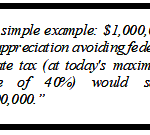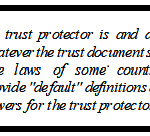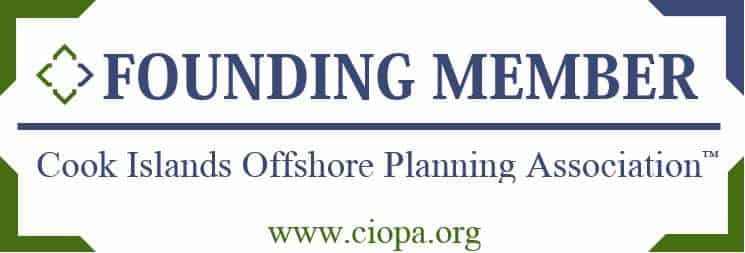Asset Protection – Going Offshore May Yield the Best Results
Published by: Florida CPA Today
Author: Howard Rosen, Esq.
Date of Publication: May, 2005
Years ago asset protection planning was an infrequently discussed topic between CPAs and their clients. Today, however, the topic often arises. Therefore, CPAs must have a basic knowledge of the strategies and techniques available to their clients to be able to intelligently respond to client inquiries.
Goal of Asset Protection Planning
The goal of asset protection planning is to lower your client’s financial profile. Lowering the client’s financial profile makes the client a far less attractive target to a litigator (because of issues such as doubt as to collectibility), and this diminishes the likelihood that your client will be sued, or, if sued, enhances the likelihood of a settlement favorable to the client. This goal is achieved by restructuring the client’s financial affairs in such a way as to place his assets beyond the reach of future potential creditors while maintaining a beneficial interest in those assets for the client.
The Core of Asset Protection
A trust will be the cornerstone of any effective asset protection plan. Trusts have been used since the crusades to protect assets, and even the IRS definition of a trust (Treas. Reg. §301.7701-4) recognizes this ancient purpose by defining a trust as: “. . . an arrangement . . . whereby trustees take title to property for the purpose of conserving and protecting it for the beneficiaries . . . [who] may be the persons who create [the trust]” (emphasis supplied).
Why can’t a self-created protective trust be established in Florida?
Because tax law and local law are not always the same and over the years public policy laws have developed in most common-law jurisdictions which, absent a specific law to the contrary, make ineffective a trust created to protect the client’s assets for his own benefit. The solution: establish the protective trust in a place where the laws will permit a self-created protective trust.
Onshore Versus Offshore Strategies
Onshore strategies include the proper use of state creditor exemption laws1 and other protective U.S. legislation (domestic asset protection trusts2, limited partnerships, limited liability companies). When considering the use of any onshore strategy, the client should be made aware of this fact: A U.S. court can overturn (disallow) any state law exemption or protection.
For a domestic protection strategy to be effective, your client must be treated fairly by the U.S. legal system (i.e., his planning must be upheld by the court). If your client is considering U.S.-based protective planning, this point should be brought home by asking him this question: “If you are sued, are you confident that you will be treated fairly by the U.S. legal system?” If the client responds with a “no,” or says, “I don’t think so,” then offshore strategies should be considered.
Offshore Strategies
Offshore strategies typically include the use of offshore trusts3 and other entities. The mention of offshore planning will often raise (justified) concerns, including security of the client’s assets and tax issues4. Careful due diligence is the best way to effectively respond to these concerns. Make certain the client is obtaining advice from a recognized expert in the field. Reputable counsel can be checked out through the Bar or other trade and regulatory groups.
This can be analogized to getting proper medical advice: While neither you nor your client would be expected to learn how to perform a complex surgical procedure, the best chance for success in carrying out that procedure is to seek out the surgeon who specializes in the field and is recognized as an expert by his peers.
Protecting Liquid Assets
To understand how a protective offshore trust works to protect cash and publicly traded securities, one must understand there are only two ways a claimant (with a winning case) can reach trust assets: bring his case in a court that has jurisdiction over the trustee (so the court can force the trustee to give up the assets) or bring his case in a court that has jurisdiction over the trust assets (so the court can seize the assets). Why is an offshore-based strategy more effective than a U.S.-based strategy? The answer is simple: If (and this is a big “if”) the offshore strategy is properly structured and implemented, no court in the United States will have the power to undo the plan. Stated another way: No court in the United States would have the ability to force the trustee to return the assets, nor would any U.S. court have the ability to seize trust assets properly held outside the United States.
Protecting Non-Liquid Assets
i.e., those that can’t be held out of the country)
Effectively protecting assets like real estate, accounts receivable and equipment (immovable assets) requires the implementation of an ancillary strategy. The belief that real estate (for example) can be effectively protected by enclosing it in a box called a limited liability company, limited partnership, or corporation does not take into account the reality that a “result-oriented” judge (remember being treated fairly?) can disregard the entity. The only effective method available to protect an immovable asset is to make the asset unattractive to a creditor by removing its value — make the asset not worth going after (Think about it: Would you spend your time and money to sue someone if all they had was a piece of real property worth $1 million encumbered by a $950,000 mortgage?).
This technique is implemented by pledging the asset as collateral for a loan and by then protecting the loan proceeds with the client’s other liquid assets in the offshore trust. At this point, an important caution is in order: Some promoters in Florida use a loan structure to protect accounts receivable that involves protecting the loan proceeds by purchasing an annuity or life insurance contract (the “contract,” both of which have high undisclosed built-in commissions) and distributing the contract to the owners of the business as “non-taxable” deferred compensation (non-taxable because the continued ownership of the contract by the business owner is allegedly subject to a “substantial risk of forfeiture” if the owner leaves the business or loses his or her professional license)5.
This plan is very risky because of the same two principles on which its success depends: It is almost certain the “tax-free” distribution of the contract will not be tax free (because the IRS will not respect the contrived “risk of forfeiture” for a closely held business) and the ultimate protection depends upon a <em>U.S. court</ upholding the insurance/annuity exemptions6 (which can and have been successfully attacked several times). Finally, to add insult to injury, the interest paid on the loan will not be deductible because of the insurance/annuity contract acquisition thereby adding to the cost of the plan7.
The proper way to implement such a plan, to protect accounts receivable, for example, is to have the business entity within which the receivables are created form its own offshore trust, implement a loan with the accounts receivable as collateral, and fund the entity’s trust with the loan proceeds. The loan proceeds can then be invested in interest earning investments, significantly reducing the net annual interest cost of this approach. Properly structured, the trust will be a grantor trust under the Internal Revenue Code (IRC §§ 671 – 679), and all transactions between it and its grantor (in this example, the entity) will have no tax effect and no tax risk. Under this plan no insurance/annuity contract is acquired, so the loan interest will be deductible and the commission on the purchase of the insurance/annuity contract avoided.
U.S. Tax Compliance — Income Tax
Depending upon its structure, the offshore trust will be either a U.S. grantor trust or a foreign grantor trust (with a U.S. grantor) for U.S. income tax purposes. If the trust is a U.S. grantor trust, it will file Form 1041 with the “grantor trust” box in the upper left corner of page one checked. If the trust is a foreign grantor trust, it will file Form 1040NR, with the “estate or trust” box in the upper right corner checked. In both cases, an appropriate grantor information statement will be attached. This will include grantor identifying information and the items of income, deduction and credit to be reported by the grantor.
U.S. Tax Compliance — Other
If the trust has any foreign accounts, Treasury Department Form TD F 90-22.1 may be required. In addition, if the trust is a foreign trust, Forms 3520 and 3520-A will be required to be filed as well.
Conclusion
Any U.S.-based plan can be successfully attacked with the result that the assets are lost. We must ask ourselves: “Do I leave my client at the mercy of a U.S. court with a domestic plan, or do we set up a plan that a U.S. court cannot disrupt?”
1. Florida Constitution, Art. X, Sec 4 (homestead); Fla. Stat. Ch. 222 (creditor exemptions).
2. Enacted by Alaska, Delaware, Rhode Island, Nevada, Missouri, Utah, Oklahoma.
3. An offshore trust is not necessarily a foreign trust for US income tax purposes.
4. See ABC “20/20” story about convicted tax scammer Jerome Schneider.
5. Hoping that IRC §83(c)(1) will be found to apply.
6. Fla. Stat. §§222.13, 222.14.
7. IRC §264(a)(2).
This article is displayed with the permission of the publisher. Unauthorized reproductions are not permitted.
Globally recognized professional asset protection planners in U.S. Donlevy-Rosen & Rosen, P.A. is a law practice with a focus on offshore asset protection planning. Let us explain the significant difference our experience can make when you want to thoroughly protect your assets. Call 305-447-0061 or simply send us a message using our contact page



















Connect
Connect with us on the following social media platforms.